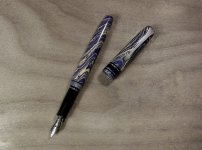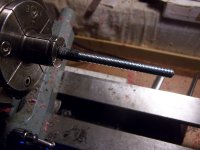I like the part of "metal frowned upon"
Try making fittings out of a bit of scrap metal called Gold...

yep, it's metal and for the sake of connoisseurs Ian is fully understanding them in the first place.

I agree with Pierre--- all the way and with what he has said.
The main reason for a set of three taps is that they are a start thread, intermediate and bottomimg.
A start thread is exactly that, for starting with in the first place. It's a nice easy taper and starts the thread right each time without causing too much stress on the material or taps.
The intermediate is often the tap that is used as the one and only tap which has a less taper than the starter tap.
The bottoming tap, is exactly that. It has no taper. If you want to get the thread completely down the whole of an enclosed plug thread then this is the one.
As you see each one has a specific task, the purest will say use all three and never miss one out.
However I am not the purest and the intermediate one will do for most of the tasks required for pen turning. if you have no experience in threading or tapping then you may well struggle in some metals.
With an intermediate for all tasks then you will need to do the threading very slowly, do a half turn and then back it off a quarter turn. Once it's in fully then you could do half turn and back half turn (or until you hear the thread you are cutting break) you will often get a feeling of a "release" when backing off.
It will be trial and error and practice makes perfect.
What I would do is invest in a metric fine set of taps and dies, you will be surprised what you can actually do with a set of them. My dad started turning and making pens many years ago using imperial taps and dies.
They still worked really well and to be honest I would often wonder if the end user really knew what thread is actually on the pen in the first place.
The only specific taps you need is the ones Pierre spoke about. Specific for feeders such as Bock.
As for wood and ebonite, you can thread wood as well. The connoisseurs you speak about may well not like the idea of glue

All in all if you should aim to make the whole of the pen, with the exception of the nib and feeder. That is including the clip, centre band.
Hope that helps.



 yep, it's metal and for the sake of connoisseurs Ian is fully understanding them in the first place.
yep, it's metal and for the sake of connoisseurs Ian is fully understanding them in the first place.


